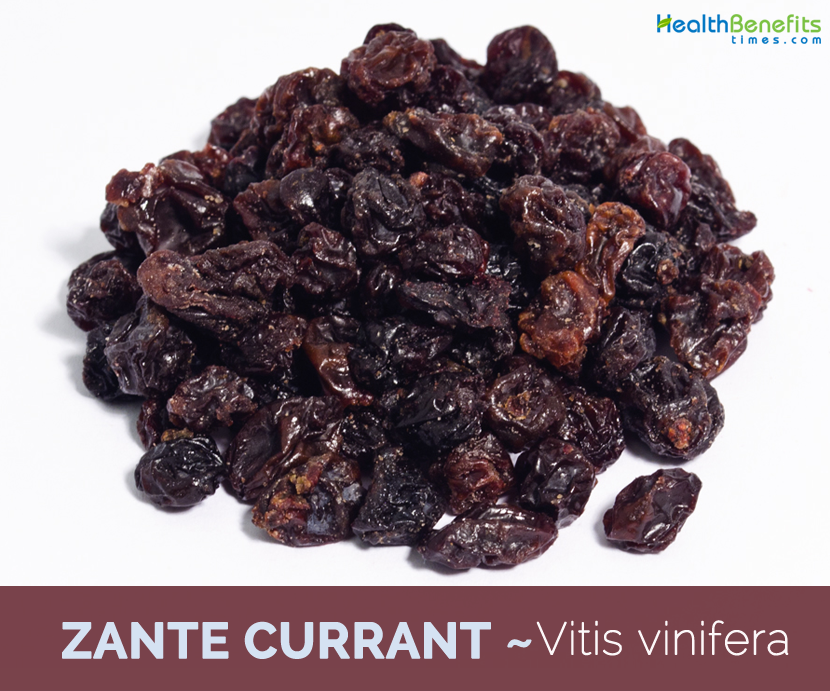| Zante Currants Quick Facts | |
|---|---|
| Name: | Zante Currants |
| Scientific Name: | Vitis vinifera |
| Origin | Greek |
| Colors | Reddish black |
| Shapes | Berries, very small 0.012–0.021 oz (0.34–0.60 g), round, with or without seeds |
| Taste | Sweet and tangy |
| Calories | 408 Kcal./cup |
| Major nutrients | Carbohydrate (82.06%) Copper (74.89%) Iron (58.63%) Vitamin B6 (32.77%) Manganese (29.35%) |
Black Corinth is also called “Champagne Grape” by epicureans (lovers of good food). Although not a true currant, when dried they are referred to as Zante Currants. Zante are used extensively in baking. The grape is dark red to black, firm skinned, juicy and crunchy with a very sweet spicy flavor when ripe. It is seedless. They have the highest sugar content of any grape grown today for the fresh market. Best of all, you can eat the stem and all. Just take the whole cluster and pop it in your mouth. It is like eating sugar. A tiny cluster can bring great elegance if laid over fish, poultry, veal, pork or beef.
History
Currant is one of the oldest known raisins. The first written record was in 75 AD by Pliny the Elder, who described a tiny, juicy, thick-skinned grape with small, bunches. The next mention is a millennium later, when the raisins became a subject of trade between Venetian merchants and Greek producers from Ionian coasts. In the 14th century, they were sold in the English market under the label Reysyns de Corauntz, and the name raisins of Corinth was recorded in the 15th century, after the Greek harbor which was the primary source of export. Gradually, the name got corrupted into currant. However, by the 17th century, trade shifted towards the Ionian Islands, particularly Zakynthos (Zante), at which time it was named Zante currant.
The first attempts to introduce the Black Corinth cultivar in the United States date back to 1854. The first successful vineyards of White and Red Corinth (related varieties), were established in California in 1861 by Colonel Ágoston Haraszthy. Around 1901, David Fairchild of USDA imported high-quality black currant cuttings from the Greek village of Panariti, a renowned producer, and established the first commercial crops. However, because of the higher popularity of Thompson Seedless, American production remained modest up to 1920s and 1930s, after which its popularity increased due to the higher prices it could bring and improved cultivation practices (girdling). The plantings reached 3,000 acres (1,200 ha) by 1936, which is approximately its current level.
Culinary Uses
- When dried, they are used in cooking, especially baking and are a major ingredient of currant slice (or currant square) and currant cake.
- In the United Kingdom, they are simply called “currants”, and often are used in scones, currant buns, Christmas cake, Christmas pudding and mincemeat.
- Fresh grapes are occasionally used by wineries for blending and color, depending on need and availability.
- Add to pancakes, muffins, or other baked goods
- Add to ice creams, cakes, or other desserts
- Mix in to yogurt, or cereals
Zante Currant Facts
The Black Corinth comes in many names like the Zante Currant but more popular for the term Champagne grape. It is an ancient type that is researched to be of the Greek origin. Even if its main results are in black, there are also some which come in red and white. The latter two are just less ordinary than the black type. This is considered one of the tiniest berries in the category of seedless grapes. Hence, growers must spray it regularly and even have its vines girdled so that all its berries would grow even.
| Name | Zante Currant |
|---|---|
| Scientific Name | Vitis vinifera |
| Native | Greek |
| Common Names | Zante currants, Corinth raisins, Corinthian raisins, currants |
| Name in Other Languages | Bulgarian: Вино Vino. Chinese: Ou zhou pu tao (歐 洲葡萄 ), Pútáo (葡萄), vitis vinifére Danish: Almindelig vin, Vin, Vinranke, Vinstok. Dutch: Wijnstok, Druif English: European grape, common grapevine, grape, grapevine, wine grape, table grape Finnish: Viiniköynnös French: Vigne cultivée, vigne, Lambrusque, Vigne sauvage, vigne vinifère German: Kultur-Weinrebe, Rebe, echter Weinstock, Rebstock, Wein, Weinrebe, Wein-Rebe Greek: Αμπέλι Ambeli, Άμπελος Ambelos (plant), Kλήμα Klima (plant), Σταφύλια Stafylia, Σταφύλι Stafyli (fruit). Icelandic: Vínber Italian: Ambrusca, Lebrusca, Vite, Vite comune , Vite selvatica, Zampino. Japanese: Yooroppu budou (ヨーロッパブドウ), Budou (ブドウ) Mangarevan: Vine Portuguese: Uva (Brazil), Videira (Brazil), Videira-europeia, Vinha, Vinho. Norwegian: Ekte vinranke Occitan: Vinha Russian: Обыкновенная виноградная Obyknobennaia vinogradnaia, Виноград Vinograd, Виноград культурный Vinograd kul’turnyi. Shona: Mugirepisi Spanish: Vino, Vid, parra Swedish: Vin, Vindruva, Vinranka Thai: Xngùn (องุ่น), A ngun. |
| Plant Growth Habit | Vigorous climber |
| Soil | Deep, loamy, humus-rich, medium moisture, well-drained soils |
| Plant Size | 16 to 20 m |
| Leaf | Medium-sized, heart-shaped, and oblong, five-lobed with deep sinuses and coarsely toothed. |
| Fruit Shape & Size | Berries, very small 0.012–0.021 oz (0.34–0.60 g), round, with or without seeds. |
| Fruit Color | Reddish black color |
| Fruit Skin | Thin |
| Flavor/Aroma | Sweet and tangy flavors |
| Major Nutrition | Carbohydrate 106.68 g (82.06%) Copper, Cu 0.674 mg (74.89%) Iron, Fe 4.69 mg (58.63%) Vitamin B6 (Pyridoxine) 0.426 mg (32.77%) Manganese, Mn 0.675 mg (29.35%) Potassium, K 1284 mg (27.32%) Total dietary Fiber 9.8 g (25.79%) Phosphorus, P 180 mg (25.71%) Vitamin B1 (Thiamin) 0.23 mg (19.17%) Vitamin B2 (Riboflavin) 0.204 mg (15.69%) Vitamin B3 (Niacin) 2.326 mg (14.54%) Magnesium, Mg 59 mg (14.05%) Calcium, Ca 124 mg (12.40%) Protein 5.88 g (11.76%) |
| Calories in 1 cup (144 gm) | 408 K cal |
| Precautions | Zante currants are nephrotoxic to dogs. |
References:
http://www.hear.org/pier/species/vitis_vinifera.htm
https://npgsweb.ars-grin.gov/gringlobal/taxonomydetail.aspx?id=426915
http://www.floracatalana.net/vitis-vinifera-l-
https://en.wikipedia.org/wiki/Zante_currant
https://www.itis.gov/servlet/SingleRpt/SingleRpt?search_topic=TSN&search_value=28629#null
https://plants.usda.gov/core/profile?symbol=VIVI5
Comments
comments
